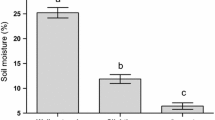Summary
This study investigated the effects of damage by the typhlocybine leafhopperOssiannilssonola callosa on the physiology of sycamore seedlings. Feeding by 20 adult leafhoppers for four days produced stippling damage of about 10% of total leaf area. Measurements immediately following removal of the leafhoppers showed a 22% decrease in photosynthesis, 25% decrease in daytime rate of water loss and a 34% increase in night-time rate of water loss, probably due to impaired stomatal function. Sixteen days later control of stomatal function was largely regained with rates of photosynthesis similar to the control plants and slightly higher rates of water loss (6.6% day, 18.0% night) attributable to the still-open feeding punctures of the leafhoppers. Daytime SO2 uptake was similar in damaged and control plants but at night the damaged plants showed a 35% increase in uptake. The hypothesis that leafhopper damage is responsible for this increase is supported by a positive relationship between uptake rate and area of leaf stippled. The physiological effects of leafhopper feeding are greater than the visible damage suggests and the effects are particularly serious when the damage is fresh. Increased rate of air pollutant entry to damaged plants is also a problem, again most marked when damage is fresh.
Similar content being viewed by others
References
Andrews KL, La Pre LF (1979) Effects of pacific spider mite on physiological processes of almond foliage. J Econ Entomol 72:651–654
Ashenden TW (1979) Effects of SO2 and NO2 pollution on transpiration ofPhaseolus vulgaris L. Environ Poll 18:45–50
Bardner R, Fletcher KE (1974) Insect infestations and their effects on the growth and yield of field crops: a review. Bull Entomol Res 64:141–160
Berge H (1973) Beziehungen zwischen Baumschädlingen und Immissionen. Anz Schaedlingskd, Pflanz Umweltschutz 46:181–195
Black CR, Black VJ (1979) The effects of low concentrations of SO2 on stomatal conductance and epidermal cell survival in field bean (Vicia faba L.). J Exp Bot 30:291–298
Braun S, Fluckiger W (1985) Increased population of the aphidAphis pomi at a motorway: Part 1 — Field evaluation. Environ Poll (Ser A) 33:107–120
Brito RM, Stern VM, Sauces FV (1986) Physiological response of cotton plants to feeding of threeTetranychus spider mite species (Acari: Tetranychidae). J Econ Entomol 79:1217–1220
Crawley MJ (1983) Herbivory: The dynamics of animal-plant interactions. Blackwell Scientific Publications, Oxford
Dohmen GP, McNeill S, Bell JNB (1984) Air pollution increasesAphis fabae pest potential. Nature 307:52–53
Dohmen GP (1985) Secondary effects of air pollution: Enhanced aphid growth. Environ Poll (Ser A) 39:227–234
Endress AG, Post SL (1985) Altered feeding preference of Mexican bean beetle,Epilachna varivestis, for ozonated soybean foliage. Environ Poll (Ser A) 39:9–16
Garsed SG, Farrar JF, Rutter AJ (1979) The effects of low concentrations of SO2 on the growth of four broadleaved tree species. J Appl Ecol 16:217–226
Kulman HM (1971) The effects of insect defoliation on growth and mortality of trees. Ann Rev Entomol 16:289–324
Nowak RS, Caldwell MM (1984) A test of compensatory photosynthesis in the field: implications for herbivory tolerance. Oecologia 61:311–318
Parker MA (1985) Grasshopper attack and water balance of the shrubGutierrezia microcephala. Am Midl Nat 113:193–197
Pollard DG (1968) Stylet penetration and feeding damage ofEupteryx melissae (Curtis) on sage. Proc R Entomol Soc London (A) 44:173–185
Przybylski Z (1979) The effect of automobile exhaust gases on the arthropods of cultivated plants, meadows and orchards. Environ Poll (Ser A) 19:157–161
Rafes PM (1973) Estimation of the effects of phytophagous insects on forest production. In: Reichle DE (ed) Ecological Studies 1. Analysis of temperate forest ecosystems. Springer, Berlin Heidelberg New York, pp 100–106
Rosen PM, Runeckles VC (1976) Interactions of ozone and greenhouse whitefly in plant injury. Environ Cons 3:70–71
Unsworth MH, Fowler D (1987) Deposition of pollutants on plants and soils; principles and pathways. In: Mathy P (ed). Air pollution and ecosystems. Proc Int Symp, Grenoble, France, May 18–22, 1987
Unsworth MH, Biscoe PV, Pinckhey HR (1972) Stomatal responses to SO2. Nature 239:458–459
Villement C (1981) Influence da la pollution atmospherique sur les populations d'aphides du pin sylvestre foret de Roumare (Seine-Maritime). Environ Poll (Ser A) 24:245–262
Warrington S (1987) Relationship between SO2 dose and growth of the pea aphid,Acyrthosiphum pisum. Environ Poll 43:155–162
Whittaker JB (1984) Responses of sycamore (Acer pseudoplatanus) to damage by a typhlocybine leafhopper,Ossiannilssonola callosa. J Ecol 72:455–462
Author information
Authors and Affiliations
Rights and permissions
About this article
Cite this article
Warrington, S., Cottam, D.A. & Whittaker, J.B. Effects of insect damage on photosynthesis, transpiration and SO2 uptake by sycamore. Oecologia 80, 136–139 (1989). https://doi.org/10.1007/BF00789943
Received:
Published:
Issue Date:
DOI: https://doi.org/10.1007/BF00789943




